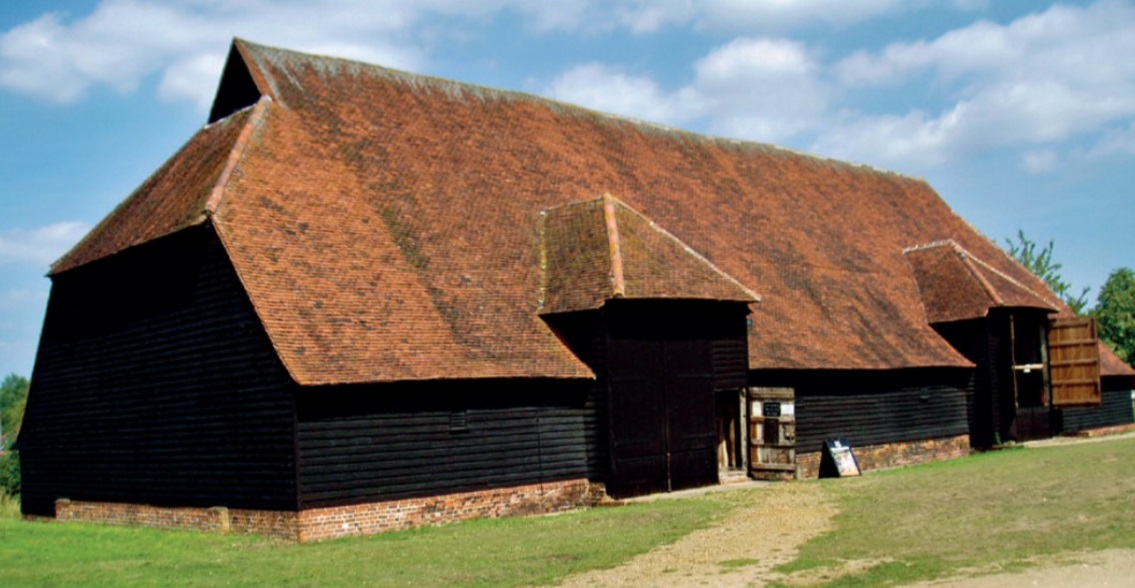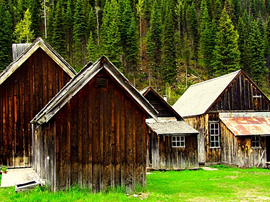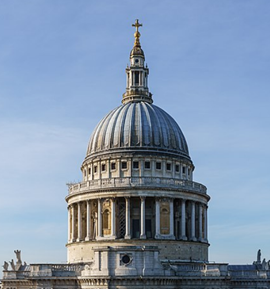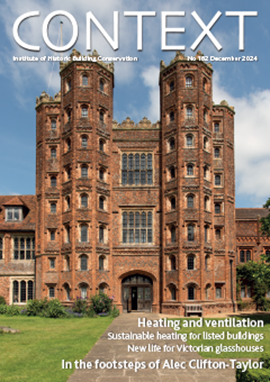Tithe barns
Tithes were certainly part of why monasteries built the often awe-inspiring medieval great barns, but the main clue is in the endowments of land which they received.

|
| Coggeshall Abbey’s Grange barn in Essex may be the oldest surviving monastic barn in England, its timber having been dated to the twelfth century. It was substantially rebuilt in 1983–4 after years of neglect, thanks to a determined local society. The roof tiles are hand-made. (Photo: Jinx Newley). |
A barn like Great Coxwell, Oxfordshire, or the Barley Barn and the Wheat Barn at Cressing Temple, Essex, bring us closer to medieval England than most old buildings. They are, as it were, unvarnished, without the extensions, alterations and embellishments that churches or houses tend to. This is not to say that the ‘great barns’ still standing are completely as built; over five centuries, and in some cases as many as eight centuries, they have had structural features modernised or renewed. Most are no longer in agricultural use, but in recent times some have been considered worthy of extensive repairs to preserve them and are open for a variety of public uses. Coggeshall Grange Barn was almost completely rebuilt.
The great size of barns like these, and the intricacy and amount of timber supporting the roofs, are awe-inspiring. They are immediately recognisable in the landscape by the size and shape of the roofs, reaching down almost to head height. The roofs of the two great barns at Cressing together contain 160,000 tiles.[1]
The architect or carpenter of a great barn selected oak trees to give the height and width desired with the minimum of lengthwise sawing. The great barn at Widdington in Essex was built with some 400 oaks, and the largest barns used perhaps 500.[2] Making a single barn as large as possible was more cost-effective than building several. Coggeshall and Great Coxwell are aisled barns, a technique adopted to achieve greater width. Coggeshall measures 120 ft x 45 ft (36.6 m x 13.7 m), Great Coxwell 144 ft x 38 ft (43.9 m x 11.6 m). Aisled barns are more often found in the east and south-east of England, while a form of cruck construction was more common in the west and north. Bradford-on-Avon, Wiltshire, for example, is a magnificent cruck-framed barn 168 ft x 30 ft (51 m x 9 m). Leigh Court, Worcestershire, 140 ft x 34 ft (42.7 m x 10.4 m), with 11 massive full crucks, is ‘quite probably the largest extant cruck building in the world’.[3] The outer walls reflected the local availability of stone or timber.
Such ‘great barns’ were simply functional spaces in which harvested crops were stored. Their pretensions were in their size rather than in decorative features, though Glastonbury, Somerset, stood at the edge of the monastic compound and was externally more than usually decorative. Sheaves of wheat and barley were stacked up within them, and gradually during the winter months the grain was threshed out. Oats and pease might be stored in different areas of the barn. Porches to keep the rain off were high enough to take a waiting loaded cart, which when unloaded could leave on the further side. The threshing floor was between the two doors; in the winter men would toss sheaves on to the floor, and beat the grain to free it from husks. The doors were left ajar to create a draught to blow the husks away.
Examples of exceptionally large barns which survive include Alciston (West Sussex), Frindsbury (Kent), Frocester (Gloucestershire), Middle Littleton (Worcestershire) and Tisbury (Wiltshire). Others have either burnt down, collapsed or blown down. Five barns were blown down in the storm of 1660 in just one parish, Sunningwell (now in Oxfordshire), but Thomas Baskerville, who wrote about them in verse, noted of four great barns, Coxwell, Cholsey, Cumnor, and Fitzharris in Abingdon: ‘These Barns stood up so stiff and stout/ No winds did hurl these four about/ In year of Charles Restauration/ A dreadfull wind did grieve this Nation.’[4]
Of the four, only Coxwell survives. Cholsey (Berkshire), which was the longest known at 303 ft (92 m), was demolished in 1815, and Cumnor in 1810. Fitzharris is undocumented.
These great barns attract the popular designation ‘tithe barn’. Notably they were built by monasteries, or in Cressing Temple by the Knights Templar, a religious military order. One explanation for the name ‘tithe barn’ is that it seems to represent a folk memory, a popular understanding and resentment at losing a proportion of their crops to often wealthy religious foundations. Historically, it is a great simplification of a complicated set of legal requirements.
Tithe is the Anglo-Saxon word for ‘tenth’. While contributing a tenth of produce to support a priest has ancient origins, the official adoption of Christianity by Anglo-Saxon kings meant that by the early tenth century there were laws enforcing payment. It was not a simple or uniform tax. There were different customs from place to place as to what should be paid.[5] Produce from the soil was naturally not the same everywhere, while the local landowner or lord of the manor often divided the tithes from his estate among several churches. The rectors or vicars of parish churches might collect all or only part of the tithes, while cathedrals and monasteries might collect other parts.
Tithes were categorised as ‘great tithes’, the tax on wheat and barley, and ‘small tithes’, the produce of gardens, small sums of money paid by householders, and less valuable agricultural produce. Fiddly to collect, the small tithes were often assigned to the local vicar, while the great tithes were more valuable to the rector or monastery. When a monastery ‘appropriated’ the church and itself became the rector, thereafter collecting the tithes, the bishop tried to ensure that a vicar was instituted to look after the parish. Tithe was paid in kind, not money. Hundreds of years later, when parliament agreed an act in 1836 to commute all remaining tithes into money rents, tithes had already been commuted by agreement in some places, while in others they had been extinguished completely and the church compensated with land. Rent charges as determined as a result of the Tithe Commutation Act were finally abolished 100 years later, in 1936.
Great Coxwell and the two barns at Cressing Temple illustrate the structure of monastic estates. The home farms were more important than the church which each also acquired, and were much larger than the land allocated to the local rector of the parish church. Great Coxwell was part of Faringdon manor, a large Domesday estate held by the king. In 1205 the manor was granted for the founding of a Cistercian monastery, but it very soon moved to a different site in the New Forest and became known as Beaulieu Abbey. In 1232 the abbey appropriated Coxwell chapel, becoming the rector; it added the rector’s land, some 50 acres, to the home farm of Coxwell manor, and gained the right to collect the tithes. A vicar was appointed who was allowed a small share of the great tithes, all the small tithes and a money payment of £2 a year.
Beaulieu organised a grange in Great Coxwell to administer the Faringdon estate, and the great barn was built about 1300. Crops stored in the barn were principally wheat and oats, with some barley and rye. A certain amount of produce was consumed by the staff at the grange or farmhouse, but most was sold during the year in Faringdon market, raising cash for the Beaulieu monks. Only the wool clip was transported to Beaulieu, and sold to Italian clothiers; the monastery had over 5,000 sheep altogether. The monastery’s own farmland in Coxwell brought in some six times more revenue than the tithes paid by the other farmers in the parish after the monastery appropriated them.[6]
The Barley Barn and the Wheat Barn at Cressing Temple are a vivid demonstration of the size of the Templars’ estate. Founded in Jerusalem in 1118 to protect pilgrims and to fight against the Turks at the time of the crusades, the Templars or the Poor Fellow-Soldiers of Christ and of the Temple of Solomon quickly gained support in England, being granted estates to support their work in the Holy Land. The Templars became very wealthy, acting as bankers and diplomats to the king, but became unpopular with monarchs, the Pope and the regular church, and were suppressed in 1312.
The manor of Cressing and its church, and the manor of Witham and the administrative area around it, were granted to the Templars in 1136 by Maud, King Stephen’s queen.[7] The Cressing estate was between 1,000 and 1,300 acres (405–526 ha). More than half of the land was occupied directly by the Templars as their demesne or home farm. There were a number of freemen with small holdings, as was typical of East Anglia, and some who were unfree or serfs, all of whom were obliged to work on the Templars’ demesne. They would have owed tithes to the Templars as rector of the church.
In 1212, King John granted the Templars the right to have a market in Witham and a three-day fair, enabling them to sell their produce without paying market tolls. The Barley Barn was built about 1200, the Wheat Barn about 1280, dated by dendrochronology.[8] It has been calculated that the two barns were able to hold the entire harvest, perhaps some 41,600 sheaves, from the Templar’s demesne.[9] The main crops, as recorded in 1313, were wheat and beans, with some peas, dredge and oats. At that time there were 61 head of cattle and 461 sheep.
A second order, the Hospital of St John the Baptist of Jerusalem or Hospitallers, founded to succour pilgrims in Jerusalem two years earlier than the Templars, was granted most of the Templars’ property after they were suppressed, including Cressing and Witham, but the name of the Templars was firmly attached to Cressing. The Hospitallers surveyed their property in 1338: they had 920 acres of land in Cressing and Little Cressing, pasture for 20 oxen and 12 cows, and for 600 sheep. In Witham they had 400 acres of land, and in Rivenhall another 120 acres. Altogether the estate was 1,440 acres (583 ha).
The measurements can not be taken as necessarily accurate or comparable with modern methods, but study of the tithe surveys made as a result of the 1846 act generally confirms them. While some wheat was used in baking bread, and some barley malted for brewing ale for the small community in the manor house supervising the estate, most produce was sold in Witham market and money remitted to the Templars or Hospitallers. Wages were paid to the baker, cook, two grooms, two pages and three chaplains, one of whom was the warden. The steward was paid a fee. Cressing was a large economic enterprise.
Beaulieu was suppressed in 1538 and the Hospitallers in 1540. In many cases the king sold the right to collect tithes to a layman, the ‘lay impropriator’, together with the former religious communities’ land. This certainly increased resentment about tithes. Tithes were certainly part of why monasteries built large barns, but the main clue is in the endowments of land which they received.
- [1] Cressing Temple, a Templar and Hospitaller Manor, edited by Andrews, DD (Essex County Council 1993 and Essex Historic Buildings Group 2020).
- [2] Historic England has details of many barn structures; Cressing Temple, a Templar and Hospitaller Manor.
- [3] Bond, James (2004) Monastic Landscapes, Stroud.
- [4] Baskerville, Thomas, edited by Jones, A (forthcoming) Journeys in Industrious England, Hobnob Press, Gloucester.
- [5] Jones, A (2000) A Thousand Years of the English Parish, Moreton-in-Marsh.
- [6] Hockey, SF, editor (1975) The Beaulieu Account-Book, RHS.
- [7] Victoria County History of Essex, Volume 2.
- [8] Historic England. Dendrochronology has confirmed Cecil Hewitt’s dating of the barns as set out in The Development of Carpentry, 1200–1700 (1969).
- [9] Cressing Temple, a Templar and Hospitaller Manor.
- [10] Jones, A, editor (2021) Johannes Kip: the Gloucestershire Engravings, Hobnob Press, Gloucester.
This article originally appeared in the Institute of Historic Building Conservation’s (IHBC’s) Context 178, published in December 2023. It was written by Anthea Jones who was head of history and director of studies at Cheltenham Ladies’ College. Now retired, she is the author of several books on Gloucestershire history, most recently Johannes Kip: the Gloucestershire engravings.
--Institute of Historic Building Conservation
Related articles on Designing Buildings
IHBC NewsBlog
SAVE celebrates 50 years of campaigning 1975-2025
SAVE Britain’s Heritage has announced events across the country to celebrate bringing new life to remarkable buildings.
IHBC Annual School 2025 - Shrewsbury 12-14 June
Themed Heritage in Context – Value: Plan: Change, join in-person or online.
200th Anniversary Celebration of the Modern Railway Planned
The Stockton & Darlington Railway opened on September 27, 1825.
Competence Framework Launched for Sustainability in the Built Environment
The Construction Industry Council (CIC) and the Edge have jointly published the framework.
Historic England Launches Wellbeing Strategy for Heritage
Whether through visiting, volunteering, learning or creative practice, engaging with heritage can strengthen confidence, resilience, hope and social connections.
National Trust for Canada’s Review of 2024
Great Saves & Worst Losses Highlighted
IHBC's SelfStarter Website Undergoes Refresh
New updates and resources for emerging conservation professionals.
‘Behind the Scenes’ podcast on St. Pauls Cathedral Published
Experience the inside track on one of the world’s best known places of worship and visitor attractions.
National Audit Office (NAO) says Government building maintenance backlog is at least £49 billion
The public spending watchdog will need to consider the best way to manage its assets to bring property condition to a satisfactory level.
IHBC Publishes C182 focused on Heating and Ventilation
The latest issue of Context explores sustainable heating for listed buildings and more.
















